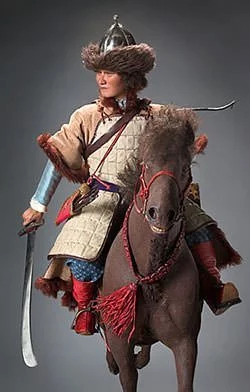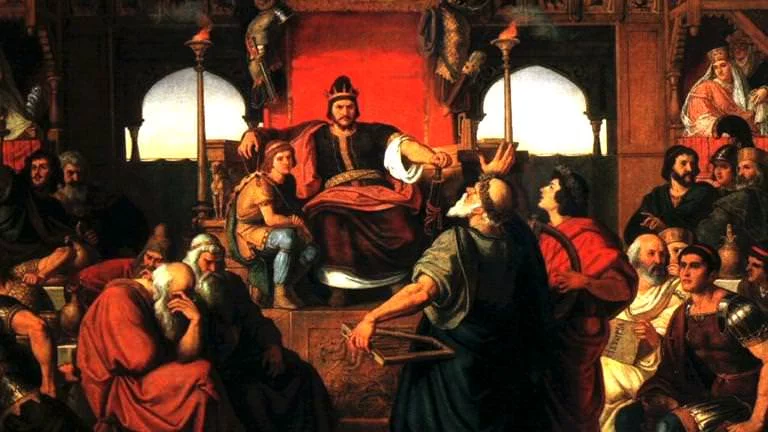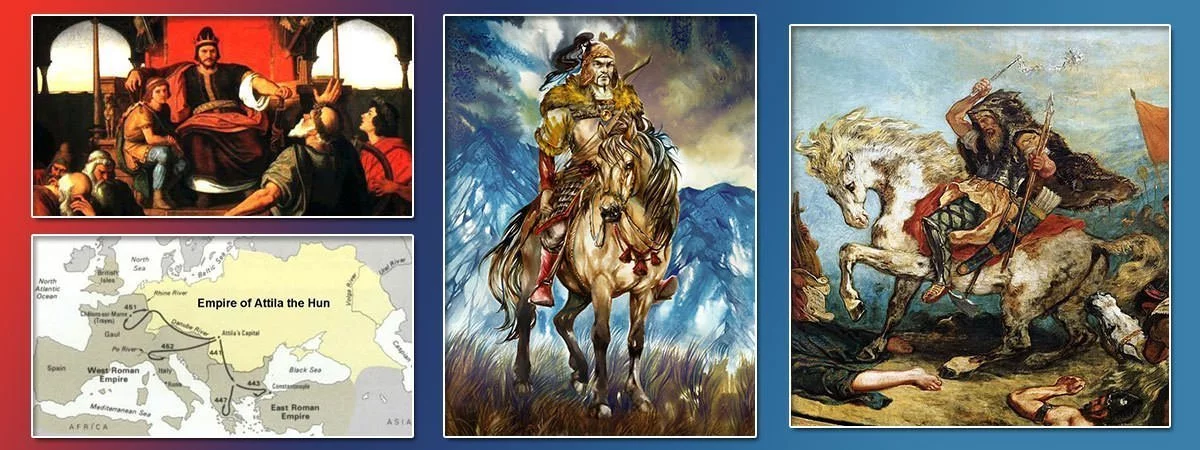Attila was the ruler of the Huns who took their empire to unprecedented heights. He was a great military leader who led the Huns to several victories over the mighty Roman Empire. Such was the fear Attila generated in his enemies that he was known as the Scourge of God. Know more about the life, reign, military campaigns and death of Attila the Hun through these 10 interesting facts.
#1 ATTILA’S UNCLE RUGILA LED THE HUNS DURING THEIR EARLY VICTORIES
The Huns were nomads who lived in Europe and Asia from 1st to 7th century AD. Due to their exploits they have developed a reputation of being fierce warriors. Though the exact date of his birth is not known with certainty, Attila the Hun was born around the advent of fifth century AD. His father Mundzuk was the brother of Kings Octar and Rugila, who jointly ruled over the Hunnic Empire in the early fifth century. After the death of Octar around 430 AD, Rugila became the sole ruler. Rugila is considered an important forerunner to Attila as he played a major role in the early victories of the Huns over the Roman Empire.

#2 ATTILA AND HIS BROTHER BLEDA BECAME JOINT RULERS OF THE HUNS IN 434 AD
After the death of Rugila in 434 AD, Attila and his brother Bleda became joint rulers of the united Hun tribes. Soon after becoming joint rulers, the brothers negotiated a peace treaty with the Eastern Roman Empire known as the Treaty of Margus. According to it the Romans agreed to pay 700 pounds (300 kilograms) of gold to the Huns every year, which was double the previous amount; to open their markets to Hun traders; and to pay a ransom of 8 gold coins for every Roman taken prisoner by the Huns.
#3 HE LED THE HUNS IN THEIR SUCCESSFUL CAMPAIGN AGAINST THE ROMANS
In 440 the Huns attacked a Roman fortress and the Romans stopped delivery of the yearly tribute. War broke out between the two empires. The Huns led by Attila and Bleda handed defeat after defeat on the Eastern Roman Empire which was ruled by Theodosius II. In 443 the Huns destroyed a Roman army outside Constantinople. This was followed by the Huns annihilating a significant portion of the Eastern Roman army at the Battle of Chersonesus.

#4 He BECAME SOLE KING OF THE HUNNIC EMPIRE IN 445 AD
In 443 AD, after the Romans had suffered numerous defeats, Emperor Theodosius send his diplomat to negotiate a peace treaty. The Huns agreed to withdraw in exchange of humiliating concessions. The Romans agreed to give 6,000 Roman pounds (2000 kg) of gold as punishment for breaching the treaty; the annual tribute was raised three times to 2,100 Roman pounds (700 kg) in gold; and the ransom for each Roman prisoner was raised to 12 gold coins. A couple of years after the treaty Bleda died making Attila the sole king of the Huns. Though several historians consider that Bleda was killed by Attila, this cannot be established with certainty.

#5 ATTILA DEFEATED THE EASTERN ROMAN EMPIRE SEVERAL TIMES
Attila the Hun again attacked the Eastern Roman Empire in 447 AD. He defeated a Roman army led by Arnegisclus at the Battle of the Utus though he himself suffered severe losses. Attila then led a devastating invasion of the Balkans and marched into Eastern Roman as far south as Thermopylae. The capital Constantinople itself was preserved due to the reconstruction of its walls. Disease forced the Huns to retreat. The war came to an end in 449 and a treaty was struck by which the Romans had to pay a large annual tribute.
#6 HE CLAIMED HALF THE WESTERN ROMAN EMPIRE AFTER A MESSAGE FROM THE EMPEROR’S SISTER
Throughout his raids of the Eastern Empire, Attila maintained friendly relations with the Western Roman Empire, especially with Flavius Aetius, the powerful general considered the most influential man in the empire. However, in 450 AD, Honoria, sister of the Western Roman Emperor Valentinian III, sent Attila a ring and requested him to rescue her from a wedding to a Roman senator that had been arranged for her. Attila responded by claiming her as his wife and half of the Western Roman Empire as his dowry. It was after much persuasion by his mother that Velentinian III spared his sister’s life.

#7 HE WAS DEFEATED IN THE BATTLE OF THE CATALAUNIAN PLAINS
In 451, Attila led an invasion of Gaul. He first attacked Metz and then his armies continued westwards passing both Paris and Troyes to lay siege to Orleans. Aetius combined forces with the king of Visigoth Theodoric I to repel the Huns. The decisive engagement between Attila and the Visigothic-Roman alliance was the Battle of the Catalaunian Plains. After fierce fighting in which Theodoric I was killed, the Visigothic-Roman alliance was able to force Attila to retreat back to non-Roman lands. This was Attila’s first and only defeat.

#8 HISTORIANS DEBATE OVER HIS SUDDEN WITHDRAWAL FROM HIS INVASION OF ITALY
In 452, Attila renewed his claim of marriage with Honoria. He invaded Italy and sacked several cities, including Aquileia, Patavium (Padua), Verona and Mediolanum (Milan). Aetius was not able to stop him. Attila was heading for Rome when Emperor Valentinian III sent three envoys including Pope Leo I to negotiate with him. Attila decided to withdraw but why he did so is not known with certainty. Earlier historians gave the credit to Pope Leo I for persuading Attila to turn back from his invasion. Modern historians have come up with several theories regarding Attila’s sudden withdrawal including shortage of food supply for his men, plague in Italy and his army already being laden with booty.

#9 ATTILA THE HUN MOST PROBABLY DIED DUE TO A NOSEBLEED
Theodosius II, the Emperor of the Eastern Roman Empire, died in 450 AD. He was succeeded by Roman general Marcian. In late 450 Eastern Roma under Marcian stopped paying tribute to the Huns. After returning from his Italy invasion, Attila planned to strike at Constantinople again to reclaim the tribute. However Attila died in early 453 AD on the wedding night of one of his numerous marriages, this time to a beautiful maid named Ildico. There are various theories regarding how Attila died with the most prominent one being that he suffered a severe nosebleed which killed him while he slept.

#10 He TOOK THE HUNNIC EMPIRE TO UNPRECEDENTED HEIGHTS
After the death of Attila, the Hunnic Empire was divided among his sons and soon collapsed. During his time, Attila the Hun was dubbed as “Flagellum Dei”, the scourge of God; and it was said that “the grass never grew on the spot where his horse had trod”. He took the Hunnic Empire to unprecedented heights and is considered their greatest ruler. He almost brought the great Roman Empire to its knees giving undeniable proof of his brilliance as a military commander. He is among the most renowned kings of the ancient world and there are numerous legends associated with him like his famous Sword of War God.

SWORD OF THE WAR GOD
The Sword of the War God, also known as Sword of Attila and Sword of Mars, was the primary military weapon of Attila, which according to legend was granted to him by Mars, the god of war. According to Greek historian Priscus, the sword was given to Attila by a herdsman who found it after one of his cows was injured by it while grazing. Looking at the magnificent sword, Attila concluded that he had been granted invincibility in war through the sword. The Sword of Mars contributed to Attila’s reputation as “the Scourge of God,” a divinely-appointed punisher.


omg this saved my english grade thx so much
Thank you very much for helping with my research, this was easily digestible and really interesting.
Happy to help.
very helpful, Thanks dude
Happy to help.
Ummm i needed this for a report and it really helped
heh yoou posted this on my birthday